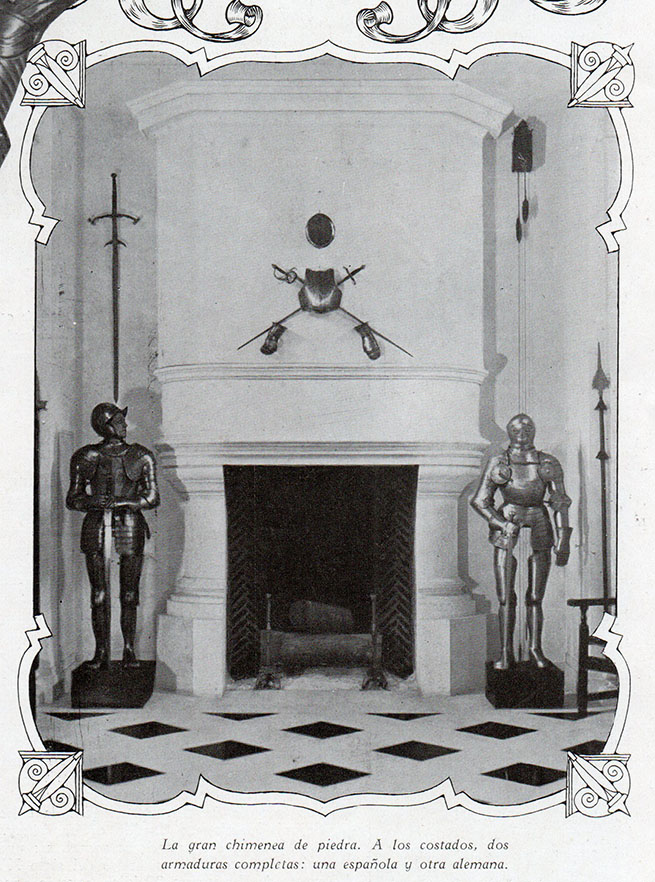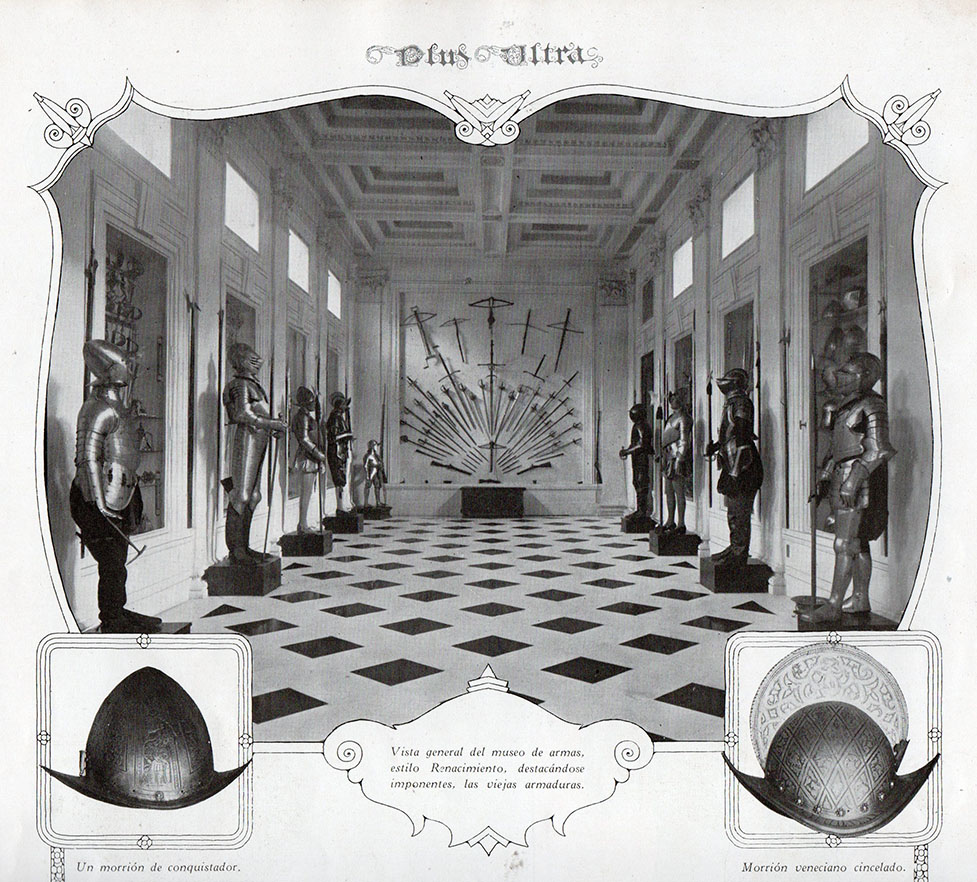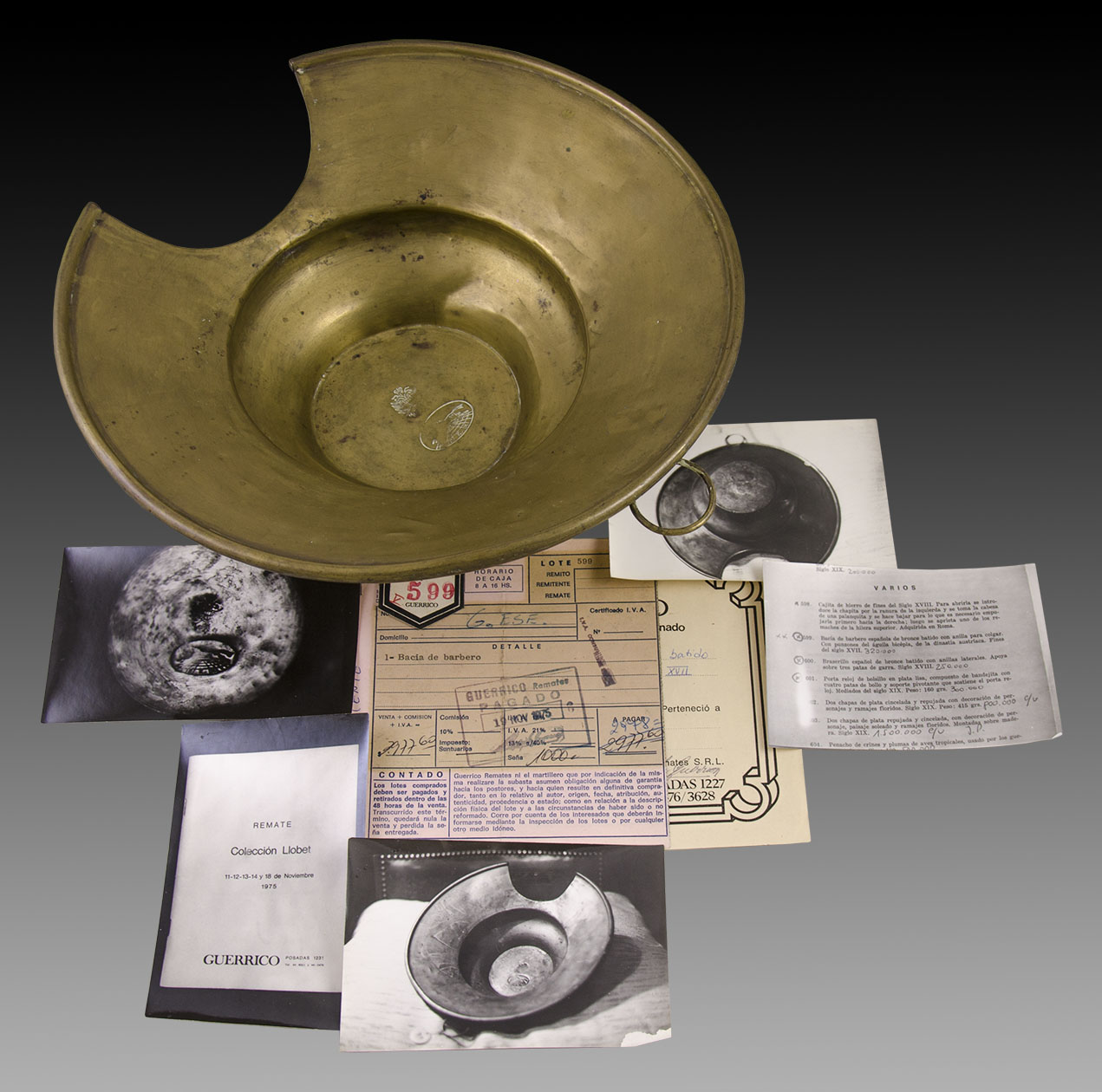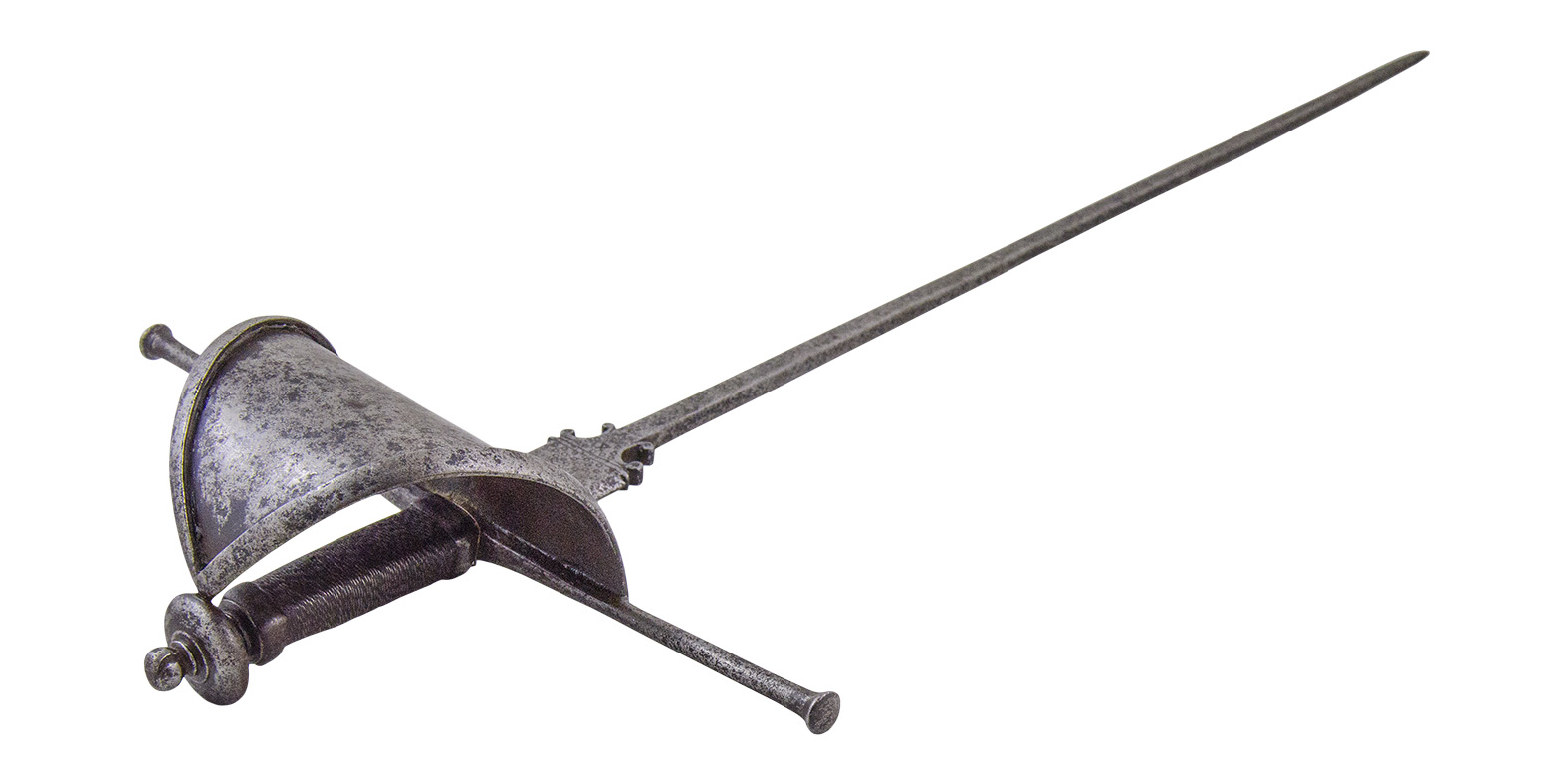The man
Jorge Llobet Cullen was born in Buenos Aires on December 16, 1889. His parents were Dr. Andrés F. Llobet and María Luisa Cullen. He married María Teresa Guerrero in 1918. An outstanding sportsman, renowned athlete, record holder and inter-American champion in hammer, discus and shot put, from 1910 to 1926, he was also a well-known landowner. He died in Buenos Aires on September 7, 1951 at 61 years of age. He was succeeded by his children María Teresa Llobet de Delfino and Andrés Francisco Llobet.
The collection
Llobet Cullen began his collection in 1908, when he began to acquire weapons and also Creole silverware that he gathered in the house of his father, Dr. Andrés Llobet at Rodríguez Peña n° 1229, in the city of Buenos Aires. . After the death of his father-in-law, Carlos F. Guerrero, in 1923, he moved to Juncal n ° 1081 (and Cerrito), a building demolished with the expansion of Avenida 9 de Julio, where the three thousand pieces that with the years gathered they found a definitive location.
The Weapons Room
At his address at Juncal n° 1081, the oploteca, which comprised seven sections, dedicated respectively to rifles, pistols, swords, helmets, spears, armor and daggers, occupied a large Weapons Room, in the Italian Renaissance style, specially built, in One end of which had a large stone fireplace with andiron, a 16th century utensil composed of two metal bars that served as a trestle or support for firewood. On the side walls, the display cases built into the wall and illuminated from the inside showed sets of cuirasses, helmets, crossbows, harquebuses, pistols, swords, daggers, rapiers, cuirasses, stilettos, daggers, other instruments of defense, stirrups and spurs. The free spaces between display cases were occupied by thirteen suits of armor mounted on mannequins.
Armor
In 1930 the Llobet Cullen collection had thirteen complete European suits of armor; It was a respectable number. The Royal Museum of Antiquities and Armor in Brussels had fourteen in 1880 [1]. Currently, the large collections of armor exhibited in various prominent public museums are known: the Royal Armory, of the National Heritage, in Madrid; the Imperial Armory (Hofjagd und Rüstkammer) of Vienna, in the Hofburg Palace, on Heldenplatz; the Universalmuseum Joanneum Landeszeughaus in Graz (Herrengasse 16); the Musée de l'Armée in Paris (129, rue de Grenelle); the Wallace Collection at Herford House, Manchester Square, London and the super-modern Royal Armories Museum in Leeds, northern England. But along with them there have existed and there are important private collections. Some were dispersed in the past, such as the one that belonged to Louis-Henri de Bourbon, reputed to be the most complete in Europe, sold at a low price. Others, of great wealth, are open to the public.
Among these reservoirs, the Stibbert Museum in Florence (Via Federico Stibbert, 26) and the Bagatti-Valsecchi Museum in Milan (Via Gesù, 5) stand out in Italy. Most of the 400 European arms and armor, mainly German and Italian from the 16th century, in the Fitzwilliam Museum (Trumpington Street, Cambridge), are the product of the generous bequest of Mr. James Henderson, who collected much of them during the 1920s from the magnificent collection of the Radziwiłł princes in Nieśwież (Poland), and today it is considered one of the best in the United Kingdom, second in rank and quality after the royal and national ones. In North America, philanthropist and collector Ronal Lauder, cosmetics magnate and friend and supporter of Donald Trump, on December 9, 2020, donated a valuable set of 91 weapons and armor to the Metropolitan Museum of Art in New York, the most important donation received since 1942.
In the Llobet Cullen Arms Room, on both sides of the fireplace, two complete suits of armor were displayed: a Spanish one, from the mid-16th century, exquisitely engraved, 1.90 m high and weighing 22 kg, armed with a sword hand and a half, chiseled, and the other armor, German, from 1530, with the Nuremberg punch, all engraved, of the type that follows the Maximilians, armed with a sword from the same period, from the collection that Georg Jakob Paul von Decker, born in Berlin in 1840 and died in July 1891, had formed his castle in Boberstein, Silesia (Prussia), acquired in 1880.
The corselet or half armor up to the knee with the Augsburg punch on the ruff, from the end of the 16th century, was 2.07 m high and weighed 27 kg, with a lasso sword from the same period with a length of 1.42 m, which belonged to the collection of Prince Antoni Wilhelm Radziwill (1833-1904), of the Polish-Lithuanian nobility and general of artillery in the Prussian army.
Another of the suits of armor, from 1480, made with a hammer and marked with Nuremberg punches, belonged to Duke George of Saxe-Meiningen, born in 1866 and a great lover of the antiquities that he gathered in his Landsberg castle, in Thuringia, after his death. in 1914 by his eldest son Bernardo, the last duke, after whose death on January 16, 1928, the castle was sold, it then passed into the hands of third parties and today it is a hotel venture.
Finally, it is not possible to omit in this very tight review a piece of armor, from the famous armory that belonged to Mariano Téllez Girón, Duke of Osuna y del Infantado and Count of Benavente, who gathered it in his house, palace of Las Vistillas in 1853. From the Duchy of Infantado came weapons that had made up the collection of 126 knight's armor that, in 1585, Iñigo López de Mendoza, fifth Duke of Infantado, had in Guadalajara. Upon the death of the last Duke of Infantado, that collection was put up for sale, and when Téllez Girón bought it to rescue it, it was already very damaged and in disarray, with pieces missing and others in need of repair. But even so he managed to gather sixty complete suits of armor from the factories of Spain, Germany, Italy and Flanders, which had belonged to dukes, officers, squires and soldiers and to two American chiefs. [2]
The Llobet collection was completed with corselet or half armor, individual pieces (such as cheek guards, mitts, shoulder pads, gorgets, ruffs, greaves, boots), two hundred head coverings (bacinetes, helmets, helmets, almetes or morrions), horse armor harnesses, tournament chairs, bibs, fences, footrests, etc. [3].
Portable weapons
Considered the most important in our country (after that formed by General Garmendia) and only comparable in South America to that formed in Peru by Miguel Mujica Gallo[4], the collection of ancient portable weapons gathered by Llobet Cullen, was formed with pieces from private European collections, such as those that had belonged to Tsar Alexander II of Russia, to the princes Frederick Charles of Prussia and Antoni Radziwil, to the dukes of Saxe-Meiningen, Osuna and Rovigo, to the Marquis of Beauchamp, to the Baroness von Vincke and Baron Giulio Franchetti (1840-1909), a well-known industrialist from Florence. Others were acquired in 1925 from a private collection auctioned in Paris [5]. And there was no shortage of those purchased in Buenos Aires: sixty of them had belonged to the collection formed by General José Ignacio Garmendia and judicially auctioned by the House of Guerrico & Williams in 1931 (including a falconete that Llobet Cullen acquired for 6,050 pesos at the time) [6], others had belonged to Estanislao S. Zeballos (1854-1923) and Dr. Esteban Buljevich (1858-1944), a well-known dentist in the Buenos Aires neighborhood of La Boca.
The comprehensive section of edged weapons from the late 15th to 17th centuries included greatswords, hand-and-a-half swords, lasso swords, cup swords, schiavonas and cross swords.
A dagger of the Lingua de bue type of Doge Pietro Lando, who ruled in Venice from 1539 to 1545, stood out: the Cinquedea dagger (five fingers) with a short and heavy blade, which had characteristic grooves on both sides, and was five fingers wide. on the handle, whose origin and largest production center was northern Italy, also known as Ox Tongue, was a civilian weapon whose belonging indicated a high social status. Weapons from other civilizations were not absent, such as a Persian scimitar and a rich cutlass. Among the blunt weapons, attention was drawn to a mace belonging to Doge Andrea Gritti, who ruled from 1523 to 1538, and axes.
The set of spears included one that belonged to Colonel Hilario Lagos who besieged Buenos Aires in 1852-53, another half-moon spear used in Entre Ríos in the mid-19th century, and one of indigenous origin. All with spear shafts.
The firearms, which Llobet Cullen knew how to disassemble and assemble with great skill, included muskets and harquebuses of all calibers (matchlock and wheel), rifles, muskets, shotguns, pistols and bottles of gunpowder. Noteworthy here was a French wheel gun from the late 1500s, marked on the barrel with the legend “Sauvage de Tourne” and on the wood “Honigean”. And there were three culverin cannons, in their gun carriages, for pound bullets, from the 17th century.
Creole silverware
The collection of Creole silverware was located in a simple enclosure in the shape of a prismatic crescent (a U-shaped display case). There, valuable sets were exhibited that included pieces acquired in 1931 at the auction of the Garmendia collection.
The reading public had the opportunity to learn about important pieces of the collection that were photographically reproduced by AlfredoTaullard [7] and Justo P. Sáenz (s) [8].
I prefer to describe the complete outfit (that is, the message plus the rope), formed by Llobet Cullen, whose silver pieces were made by the Buenos Aires goldsmith José Gallo in 1915. It consisted of a woven wool bottom from the North; sole carona, hand-drawn (punch from Talabartería Casimiro Gómez), with chiseled silver toe; Buenos Aires loin with chiseled silver head; rawhide girth and top, with embroidery of colt's tientos; brazier stirrups, of chiseled silver; a cushion of Angora goat and another of Perico-ligero; deer overlay; pegual identical to the girth; large chiseled and embossed silver breastplate, from 1850, with gold ornaments, one of which bore the coat of arms of Entre Ríos, and was believed to have belonged to General Urquiza; antique surety, of chiseled and embossed silver; complete set of reins, rawhide, with silver pins and pumps; brake of cups and pontezuela of chiseled silver. This curious and refined set was completed with the rider's clothing and accessories: a leather handle with silver coins from 1882 and 1883 and the necessary harrow; a modern chiseled silver whip and an antique herdsman, made of silver and gold rings; a pair of antique Nazarene spurs, of chiseled silver, with openwork slices and dust caps; a silver and gold knife, chiseled by the silversmith Ábalos and another with a Toledo blade, handle and sheath of English silver; ivory boleadoras and other ostriches, trimmed in lizard leather, and a donkey leather lasso [9].
We exhibited the lomillo that was part of the Llobet Cullen collection in the exhibition held at the National Museum of Decorative Arts (Buenos Aires, 2000), and it illustrated the cover and back cover of the book made at that time: El Apero Criollo. Art and Tradition. See more here
Collection destination
When Jorge Llobet Cullen died in 1951, the collections were preserved by his son Andrés (1919-1992), who also formed his own silverware collection parallel to that of his father, with pieces mostly for civil and religious use and some of Pampa origin. or mapuche. With his friend and supplier, the antique dealer Román Francisco Pardo (1902-1990) they wrote a handwritten catalog of the silverware collection. Finally, both collections of armor, weapons and silverware disintegrated when small sets were sold at the judicial auction held in 1973 by the Bullrich house, and the rest in 1975 at the Guerrico house, then located at 1231 Posadas Street. [10] from the city of Buenos Aires. The largest and most valuable part (armor and weapons) left the country. Two hunting muskets with a wheel ignition system are in the Museum of Weapons of the Nation. And the paradoxical situation arose that many of the pieces that Llobet Cullen had acquired in 1931 at the auction of General Garmendia's Weapons Museum passed through this famous auction house for the second time.
Notes:
1. E. van Vinkeroy, Musée Royal d'Antiquites et d'Armures. Catalog des collections d´armes composant la première section, Bruxelles, Bruynlant-Christophe & Cie., 1880, p. [15]-24.
2. «Library, Monetary and Armory of the Hon. Lord Duke of Osuna and Infantado", in La Illustration, universal newspaper, volume V, no. 252, Madrid, Saturday, December 24, 1853, page. 512. The view of the interior of the Armory shows a rectangular room, complete armor on the lower part of three of its walls and upwards, helmets and corselets. Llobet Cullen's Weapons Room seems inspired by that model. From the engraving published by La Illustration there is a pencil drawing, perhaps the original, by the painter, draftsman, etching artist, lithographer and restorer Cecilio Pizarro y Librado (1818-1886), from that date, found in an album with almost 300 of his drawings acquired in 2004 by the Prado Museum to Don Antonio Feijoo, owner of the well-known antique shop on Calle del Rey Francisco 7, Madrid.
3. Arturo B. González, “The Weapons Museum of Jorge Llobet Cullen”, in Plus Ultra, year XV, no. 171, Buenos Aires, July 31, 1930; “Weapons Collection of Don Jorge Llobet Cullen”, in Aconcagua. Illustrated Monthly Magazine, year I, no. 1, Buenos Aires, January 1930, pp. 67 and 68; "The oploteca of Jorge Llobet Cullen", in La Prensa, year LXIII, no. 22,794, Buenos Aires, July 24, 1932, 5th section [p. 2], with engravings
4. Ricardo Vegas García, Weapons Museum and Miguel Mujica Gallo Hunting Pavilion. Review of a Peruvian oploteca, Lima, Imp. Americana, 1956.
5. Catalogue d'armes anciennes du XVe au XVIIe siècle, curiosités militaires (Ancien Régime, Révolution, Ier Empire, Restauration, Louis-Philippe, IIe Empire), armes blanches, armes à feu, armes d'honneur, bâton du Maréchal Victor, duc de Bellune, armes orientales et diverses, cuirasses, coiffures, plaques et cuivreries, harnachement, équipement, décorations, boîtes et bibelots napoléoniens, sulfures, bronzes, porcelaines, montres, bibelots divers, meubles et objets d'ameublement, composant la collection de M. X..., et dont la vente aura lieu à Paris, Hôtel Drouot, salle N°11, les lundi 9, mardi 10, mercredi 11 et jeudi 12 mars 1925, à deux heures, Paris, Imprimerie Lahure, [1925]
6. I keep in my collection a copy of the Guerrico & Williams pamphlet, from 1931: «Judicial. Testamentary of General José Ignacio Garmendia and Maria Rufina Reynolds de Garmendia. “The Weapons Museum of General José Ignacio Garmendia” [Buenos Aires], Gadola Printing Office, which must have belonged to a member of the public who attended the auction, as it has the peculiarity of having annotated in its brief margins, in pencil and with tiny handwriting. , the names of the buyers and the price paid for each piece or lot.
7. Alfredo Taullard, Platería Sudamericana, Buenos Aires, Peuser, 1941.
8. Justo P. Sáenz (s), Gaucho horse riding in the Pampa and Mesopotamia, 2nd. edition, Buenos Aires, Peuser, 1942.
9. González, “The Weapons Museum of Jorge Llobet Cullen”; “Weapons Collection of Don Jorge Llobet Cullen”, ob. cit.
10. Considering the hierarchy of the collection, the printed catalogs for the auction, possibly made based on the appraisal recorded in the judicial file, are poor in presentation and content. Vgr. Guerrico Gallery, Llobet Collection Auction Catalog. October 1975, 1 vol. in 8th.
* Special for Hilario. Arts Letters Trades




